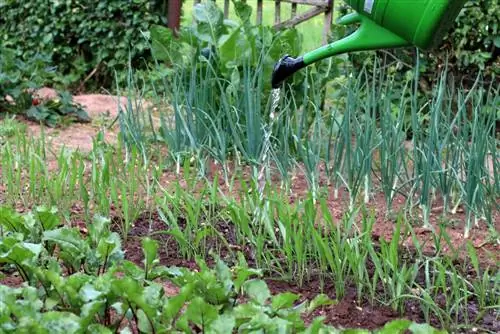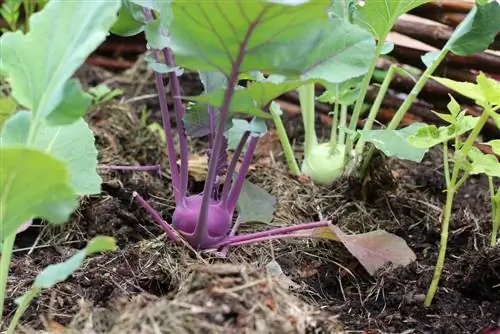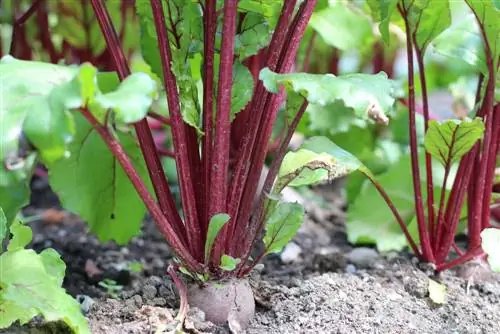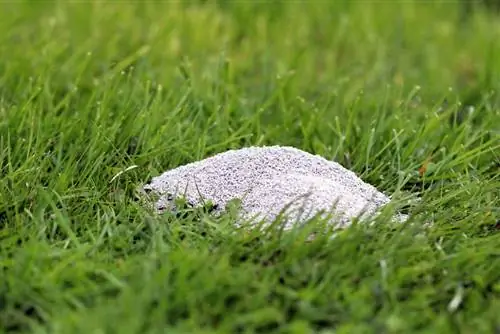- Author admin [email protected].
- Public 2023-12-17 03:39.
- Last modified 2025-01-24 12:45.
In autumn, different types of vegetables dominate the local menu than in summer. Now young and old favor a heartier treat, such as hearty kale or aromatic leeks. So that your favorite varieties can be harvested on time, the optimal dates for sowing and growing should not be missed. You can find out here when and how to skillfully plant autumn vegetables in the garden. The following list of popular varieties shows what you definitely shouldn't miss.
Selection of location and preparatory work
In order to harvest a rich harvest of delicious autumn vegetables, cultivation requires observing a few fundamental premises. The location of the vegetable patch is just as important as the condition of the soil. Where the soil does not meet the requirements, targeted optimization measures are required. This applies regardless of whether the preferred varieties are grown via direct sowing or previously grown in a manure bed, greenhouse or on the windowsill. The following factors are important:
- A sunny, warm and sheltered location
- Humose, nutrient-rich soil
- With a fine crumbly, loose consistency
- Well drained, without the risk of waterlogging
- A pH value between 6 and 7
If the soil at the chosen location turns out to be not completely satisfactory, experienced hobby gardeners know how to remedy the situation using simple means. A soil that is too sandy is enriched with ripe, sifted compost. If clayey soil tends to become compacted, a shovel of fine-grained, washed sand loosens the topsoil. With an uncomplicated test set from the hardware store, the pH value of the vegetable patch is no longer a secret. If the result turns out to be too low with a value below 5.5, the problem can be solved in no time by adding acetic vital lime, algae lime or rock powder.
Direct sowing of autumn vegetables
Several classic autumn vegetables should be sown in May, such as white cabbage or broccoli. Other varieties are sown during the summer or as late as September/October. Regardless of the exact schedule, sowing ideally takes place according to the following method:
- Weed the bed thoroughly and till it into fine crumbs
- Make furrows with the handle of a digging fork or a stick
- Distribute the seeds at a suitable distance
- Mix very fine seeds with a little sand beforehand
Light germinators are only pressed down and covered with sand or vermiculute by a maximum of 0.5 centimeters. The seed furrow is closed with substrate over dark germinators and then the seedbed is watered with a fine spray. To protect against voracious pests, protect the sowing with a net or garden fleece. In the following weeks, the bed is watered regularly and weeds are removed every few days. If the seedlings thrive too closely, the weakest specimens are sorted out. It is important to ensure that the vegetable plants are kept at an airy distance from each other as a prophylaxis against fungal infections.
Tip:
Sprinkling a vegetable patch with horsetail broth before sowing or planting reduces the risk of infections caused by soil fungi.
Planting vegetables professionally
Plants grown in the greenhouse or on the windowsill start with a robust growth lead in the bed. This means they are less susceptible to snail damage, aphid infestation or fungal infections. To skillfully plant these young plants in the garden, follow these steps:
- In advance, harden off the young vegetable plants in partial shade for 14 days
- On the day of planting, soak the still potted root balls in water until no more air bubbles appear
- In the meantime, create small pits with twice the volume of the root ball
- Make sure the planting holes are spaced appropriately, especially for large varieties
- Unpot the young plants, insert them in the middle, press down the soil and water
The planting depth in the bed should not be deeper than previously in the cultivation pot. Vegetables threatened by windthrow, such as cauliflower, are given support until they have firmly rooted in the ground. Mighty autumn vegetables, such as savoy cabbage, are deliberately planted in the ground at a close planting distance in order to harvest many small heads instead of a few large specimens. In the case of autumn lettuce, such as romaine lettuce, the hearts must not get underground when planted.
List of popular varieties
The selection of tasty vegetables for autumn is huge. The following list presents varieties that are at the top of the popularity scale. (In alphabetical order)
Broccoli (Brassica oleracea)
More nutritious than cauliflower and less demanding to care for.
- Sowing from mid-May
- Planting time from June
- Harvest from October
Kale (Brassica oleraceae var. sabellica.)
Tastes best freshly harvested after a frosty night. One of the he althiest autumn vegetables ever.
- Putting in the potty in mid-May
- Planting out at the beginning of July
- Harvest from the first frost to March
Kohlrabi (Brassica oleraceae var. gongylodes)
Children especially love the tender vegetables.
- Direct sowing of late varieties in June
- First harvest after 10 weeks
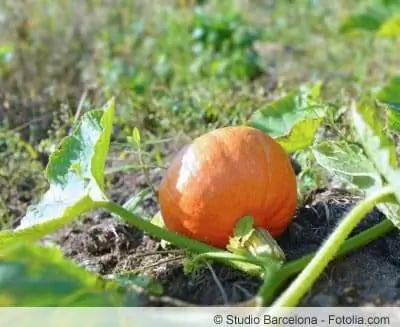
Pumpkin (Cucurbita)
At least one powerful specimen belongs in every vegetable patch. Be careful when choosing varieties, because some varieties are poisonous and are only used for decoration.
- Prepare in good time on the windowsill from March
- Planting out after the Ice Saints in mid-May
- Be sure to harvest before the first frost
Carrots (Daucus carota)
There are delicious varieties of carrots to choose from for every season. An indispensable component in the diverse vegetable garden.
- Direct sowing as autumn vegetables at the end of May/beginning of June
- Ready for harvest after 16 weeks
Roman lettuce (Lactuca sativa var. longifolia)
The appetizing salad with a firmer structure than lettuce and the extra tender hearts.
- Direct sowing possible from May to July
- Ready to harvest after 6-8 weeks
Brussels sprouts (Brassica oleraceae var. gemmifera)
A hearty classic that takes one of the longest ripening times in the garden.
- Advance from mid-May
- Planting season begins at the beginning of July
- Harvest preferably after the first frost
Beetroot (Beta vulgaris)
The foxtail plant with aromatic tubers and a long shelf life. The longer beets are stored, the richer their vitamin C content.
- Sowing in manure beds from April
- Ready for harvest after 14-16 weeks
Celery (Apium graveolens var. rapaceum)
Celeriac cannot be missing from this list. The popular vegetable tastes particularly good in autumn and is also delicious as a salad.
- Move behind glass in March
- Plant outdoors in mid-May
- Harvest in late autumn until the first frost
Turnip (Brassica napus)
A traditional autumn vegetable, not just for the farm garden. Although turnips are frost-hardy, they should be harvested as young as possible in order to enjoy them tenderly.
- Prepare in small pots in mid-May
- Planting out in July
- Harvests from September to November
Tomatoes (Solanum lycopersicum)
Growing this delicate vegetable is a challenge for every hobby gardener and results in deep satisfaction when the plant produces a bountiful harvest well into autumn. A tomato house you build yourself or cultivation in a covered warm bed significantly increases your chances of success. Wild tomatoes are less susceptible to the dreaded brown and late blight.
- Sowing from March 25th to 30th behind glass
- Planting out from mid-May under a rain cover
- Continuous harvest possible until the first frost
Jerusalem artichoke (Helianthus tuberosus)
An old vegetable variety is conquering the hearts of hobby gardeners once again. The Indian tuber is not only very he althy, but also extremely easy to care for.
- Planting time for late varieties in May
- Flowering time is in September
- Harvest in autumn and winter when the ground is not frozen
Winter garlic (Allium ampeloprasum)
The unbeatable favorite vegetable for young and old with a unique aroma.
- propagation from the beginning of April
- Planting out by the end of May for extra thick stalks
- Ready for harvest after 16 weeks
Savoy cabbage (Brassica oleracea convar. capitata var. sabauda)
A wonderfully tender autumn vegetable, rich in vitamins and at the same time low in calories.
- Sowing behind glass in March
- Planting out in May
- Ready for harvest after 24 weeks
Zucchini (Cucurbita pepo ssp. pepo convar. giromontiina)
A popular subspecies of pumpkin with an individual character. Brings tasty lightness to the autumn kitchen.
- Put early plants outdoors in May
- First harvest possible after 8 weeks until autumn
Conclusion
With the end of summer, vegetables take over in the garden, equipped with a hearty aroma and a concentrated load of vitamins. In order for the plants to develop their full potential, various fundamental aspects must be taken into account during sowing and planting. Choosing a sunny, warm location is just as important as choosing a nutrient-rich, well-drained soil with a balanced pH value of 6-7. Last but not least, the popular varieties on the list here do their best under these conditions.


